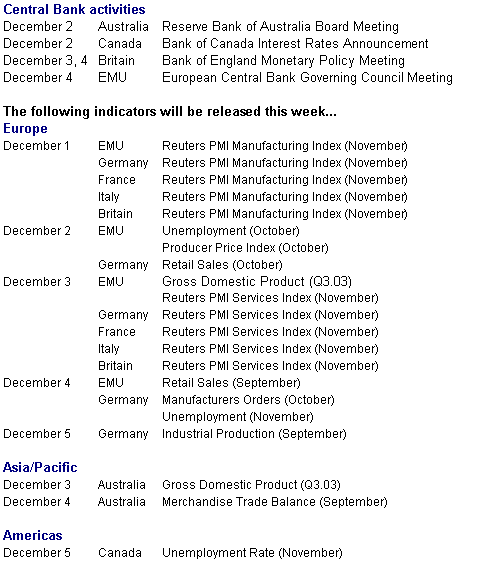Monday, December 1, 2003

Last Week's Highlights
Stability Pact dealt a blow
The dollar's decline and the apparent demise of the EMU growth and stability pact were the big brouhahas of the week. After an all-night meeting, finance ministers (Ecofin) waived penalties against France and Germany for breaching deficit limits, much to the chagrin of smaller countries. However, many feel that this was a political decision, not an economic one, so the euro - after a brief flutter downward - climbed to an all-time high against the dollar as investors once again fretted over the mammoth U.S. fiscal and current account deficits.
Rhetoric against the decision was harsh. The European Commission expressed anger that Germany and France had escaped punishment for their over-sized budget deficits that are beyond the 3 percent of GDP limit. Germany and France argued that cutbacks needed to bring their deficits in line with EU budget rules would harm Europe's fragile recovery. The European Central Bank said the deal carried serious dangers. Both countries agreed to cut deficits, but not by as much as the Commission wanted. The two will not have to make even those cuts if economic growth is less than expected.
The finance ministers' leniency with France and Germany also sparked concern at the European Central Bank (ECB). The ECB's policy council held an emergency conference call and issued a statement saying it deeply regretted the move. The Bank said that the conclusions adopted by the Ecofin Council carried serious dangers and the failure to adhere to the pact's rules "risks undermining the credibility of the institutional framework and the confidence in sound public finances of member states across the euro area." A disgruntled ECB warned that the collapse of the pact could force up interest rates.
Equities survive November
Although the week was packed with new positive economic data, market players were distracted by holidays in Japan, Singapore and the U.S. Though equities drifted in weak volume for most of the week, all of the indexes followed here managed to recoup a major chunk of their previous week's losses. Nevertheless, November saw some indexes retreat for the first time since April. Five of the indexes - Dow, All Ordinaries, Nikkei, Topix, Straits Times - were down on the month.
Global Stock Market Indexes
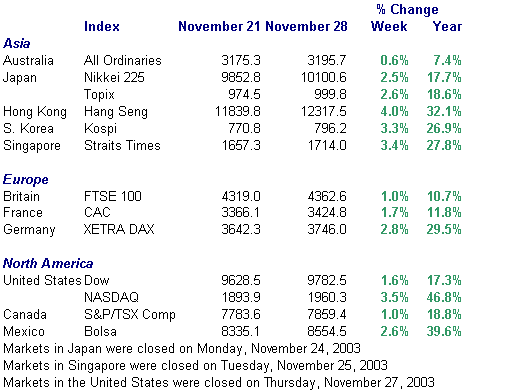
Recap of global markets
Europe and Britain
Europe and Britain continued to climb higher despite their collective pause for breath in mid-November. In November, the FTSE gained 1.8 percent, the CAC 1.5 percent, and the DAX an impressive 2.5 percent. All three managed to overcome concerns about the ever-rising sterling and euro to post gains on the week as well. Yet London markets did close lower on Friday after sterling surged against the dollar, hitting companies with extensive U.S. exposure.
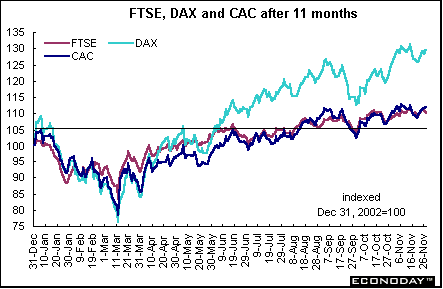
The euro rose to a fresh all-time high against the dollar as currency dealers expressed concern about financing the widening U.S. current account deficit. Stocks with large U.S. exposure were the hardest hit. On the week, European stocks rose as signs of accelerating economic growth in Europe and the U.S. boosted shares. But the gains were curtailed Friday as the dollar sank to a record low, causing concern that the value of sales generated by European companies in the U.S. may erode.
Asia/Pacific
Although all Asian/Pacific indexes tracked here were up on the week, most were down for the month of November. Only the Hang Seng and the Kospi were up on the month, up 1 percent and 1.8 percent, respectively. The Nikkei lost 4.4 percent while the Topix lost 4.2 percent as investors worried about the yen's strength and its impact on the export-led recovery. The all ordinaries also lost ground on export worries as the Australian dollar climbed against the U.S. dollar. The Straits Times slipped 0.6 percent. Japanese investors were disappointed by mixed economic data released on Friday that showed a decline in consumer spending and an increase in the unemployment rate (industrial production was up on the month.)
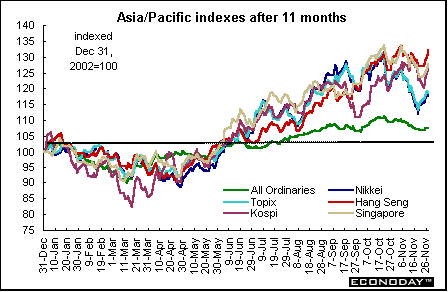
One reason the Hang Seng has outperformed many Asian indexes recently is the strength of the economy's recovery since the SARS outbreak. Aided by a surge in tourism, third quarter gross domestic product soared 6.4 percent and 4.0 percent when compared with last year. Second quarter GDP sank 3.7 percent and 0.5 percent on the year thanks mainly to the SARS epidemic that shut down tourism. This is the biggest rise Hong Kong has seen since the Special Administrative Region first began official economic growth records in 1990. The rebound was greatly assisted by China's decision to relax border restrictions with the mainland, enabling residents of neighboring Guangdong province, one of China's fastest growing regional economies, to pour into Hong Kong for shopping trips or holidays.
Americas
A strong rally on Monday petered away as U.S. investors headed into the Thanksgiving Day weekend and trading volumes sank. And positive economic data did not impact the market's direction, with pundits explaining that much of the good news was already priced into the market. Action in the U.S. markets and the direction of U.S. economic data typically play a big role in determining the direction of other world indexes. While the Dow, NASDAQ and the TSE managed to add onto Monday's gains, the Bolsa played catch up at week's end. Only the Dow was down on the month, slipping 0.2 percent. The Bolsa roared ahead 6.1 percent on the month. The NASDAQ and TSE were up by a modest 1.4 percent and 1.1 percent, respectively.
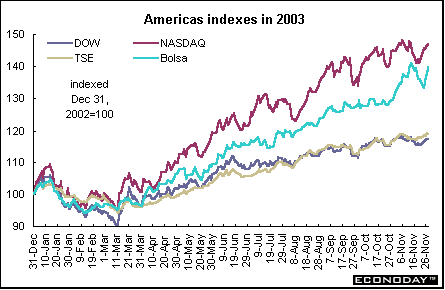
Currencies
The euro reached a record high of $1.2015 against the dollar - the highest level since its January 1999 launch. Intrepid European equity investors worry that the higher value of the euro could harm the fragile export-led recovery now underway, especially in Germany and France. With U.S. growth less of an issue after a string of positive data releases, investor concerns are focusing on the size of the U.S. current account and fiscal deficits and fears of trade wars. These are compounded by the underlying drumbeat of geopolitical worries as the situation in Iraq drags on.
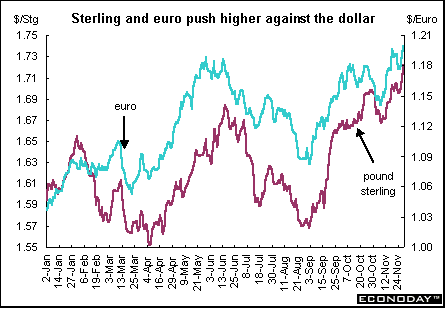
The sinking dollar also pushed the pound sterling to its highest level against the dollar since 1998. The dollar's weakness reflected worries over the financing of the U.S. trade deficit, which is currently equivalent to about 5 percent of GDP. The rising pound could spell trouble for those British companies who depend on the U.S. for a high proportion of their sales.
The dollar began its most recent slide two months ago when investors decided that the U.S. government had relaxed its traditional strong dollar policy in an effort to stimulate exports. The decline accelerated amid evidence that foreign investors could be losing their appetite for U.S. financial assets, making it more difficult for the U.S. to finance its trade deficit with the rest of the world. The U.S. depends on strong sales of shares and government bonds to foreign investors in order to pay for imported goods whose value far outstrips export earnings.
The Bank of Japan sold its currency again in November for a ninth month this year, trying to stem yen gains that threaten the nation's exports. The Bank of Japan sold ¥1.6 trillion ($14.6 billion) between October 30th and November 26th. The Bank sold ¥2.72 trillion the month before. The Ministry of Finance, which released the data, directs the central bank to buy or sell its currency. The government has been trying to slow an 8.7 percent gain in the yen in 2003 that erodes company earnings on overseas sales. Rising profits at exporters are helping Japan recover from its third recession since 1991.
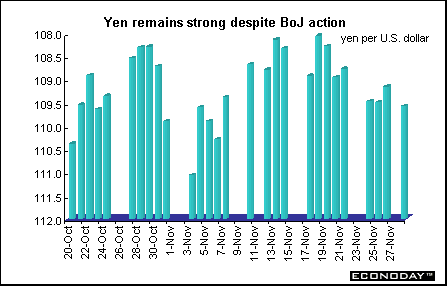
Indicator scoreboard
EMU - November flash harmonized index of consumer prices jumped 2.2 percent when compared with last year. This is above the 2 percent inflation ceiling set by the ECB. Eurostat uses early German and Italian price information along with energy prices and information from other EMU countries (if available) to compute this early estimate.
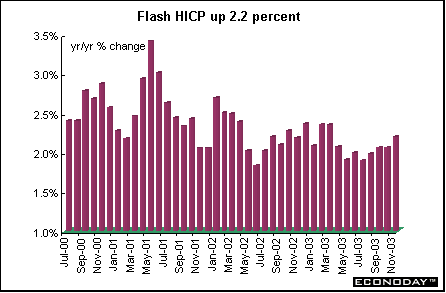
October seasonally adjusted M3 money supply growth accelerated to 8.0 percent from 7.6 percent in the previous month when compared with last year. For the three months to October M3, money supply was up 7.9 percent when compared with the same three months a year ago. This was down from 8.1 percent growth in the previous three-month period. The three-month average is the ECB's measure of money supply growth and it remains stubbornly above the Bank's 4.5 percent target.
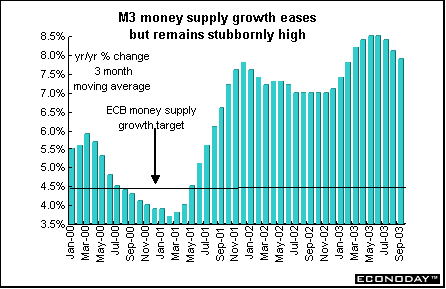
EU - November EU Commission economic sentiment index climbed to 95.9 from 95.5 in the previous month. Both industry and consumer confidence improved slightly to minus 8 and minus 17, respectively. Construction and services sectors also improved. Only retail sentiment declined.

Germany - November Ifo Institute's west German business sentiment index reading was 95.7, up from 94.3 in October. This was the seventh consecutive increase. The current conditions index increased to 83.2 from 81.2 in October. Expectations increased to 108.7 from 107.9 in October.

France - October seasonally and calendar adjusted consumer spending on manufactured goods jumped 1.6 percent and 4.3 percent when compared with last year. The volatile textile sales category soared by 8.7 percent. However, spending on durable goods sank 1.1 percent with auto sales falling 3.3 percent.
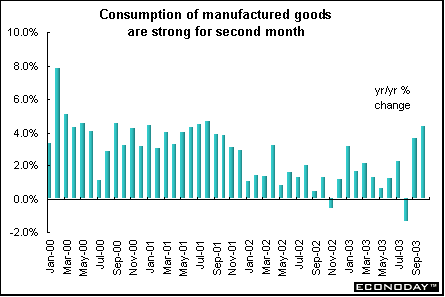
October unemployment fell by 8,000 after jumping by 37,000 in the previous month. The seasonally adjusted unemployment rate remained at 9.7 percent for the second month. The number of jobless declined to 2.631 million, according to the International Labour Organization definition which excludes jobseekers who did any work during the month.
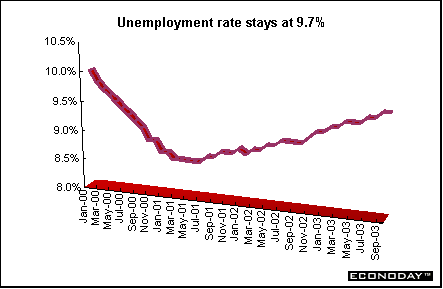
Italy - September seasonally adjusted retail sales were up 0.6 percent and 3.3 percent when compared with last year. Food sales jumped 6.1 percent on the year while non-food sales were up 1.4 percent. Food accounts for about 43 percent of retail sales.
October producer prices were unchanged and up 0.7 percent when compared with last year. Excluding energy prices, the PPI was up 0.1 percent and 1.0 percent on the year. Intermediate prices were up 0.4 percent and climbed 0.9 percent on the year.
Britain - Third quarter gross domestic product was up 0.7 percent and 2.0 percent when compared with last year. Construction output jumped 2.5 percent and was up 6.9 percent on the year. Manufacturing was unchanged on the quarter and down 0.4 percent on the year. Services, on the other hand, were up 0.8 percent on the quarter and 2.3 percent on the year. Household spending was up 0.7 percent and 2.5 percent on the year.
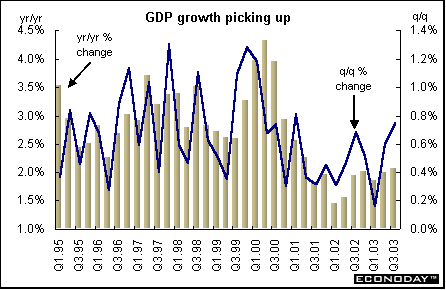
November Nationwide house price index was up 1.2 percent and by 15.2 percent when compared with last year. Price increases peaked in the first quarter of 2003 and have eased since.
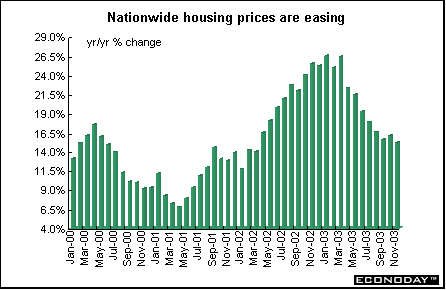
Asia
Japan - October unemployment rate edged up to 5.2 percent from 5.1 percent in the previous month. Companies continue to curb costs by cutting jobs. About 3.45 million people were out of work in October. The economy shed 220,000 jobs, the third time in four months that jobs were lost. The number of jobs available for every 100 applicants rose to 70, the highest in six years. Japan's jobless rate reached 5.5 percent twice last year and January this year - the highest since the government started keeping track in 1953. It fluctuated from 5.2 percent to 5.4 percent before easing to 5.1 percent in August.
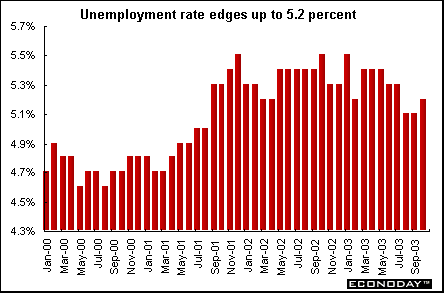
October seasonally adjusted spending by households headed by a salaried worker dropped 1.5 percent and was down 1.5 percent on the year. Household spending is being curbed by increases in medical costs and taxes and stagnant wages. The government raised workers' contributions to medical costs by half to 30 percent under the national health insurance program.
October industrial production was up 0.6 percent and 3.5 percent when compared with last year. The gains in production and exports reflect the high growth in the U.S., but the domestic economy continues to lag.
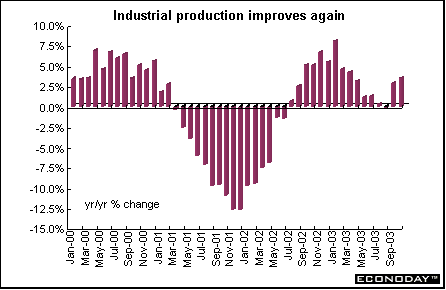
November Tokyo consumer prices were down 0.5 percent and dropped 0.8 percent when compared with last year. Tokyo core CPI, which excludes fresh food, was down 0.2 percent on the month and on the year. October nationwide CPI was unchanged on the month and on the year. Core CPI was up 0.1 percent both on the month and year. However, this was largely due to one-time factors, including recent tax increases and higher rice prices. Nationwide core CPI is the most-watched indicator of deflation - the Bank of Japan uses it as its chief price indicator in setting monetary policy. The central bank has repeated many times in recent months that the recent improvement in the CPI is temporary. It has said it expects deflation to continue through next fiscal year, which starts on April 1st, so there is no need to alter monetary policy.
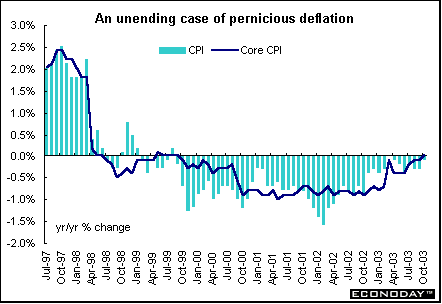
Americas
Canada - September retail sales sank 0.8 percent but were up 3.3 percent when compared with last year. In constant dollars, retails sales were down 0.8 percent. Sales dropped for autos, furniture, food and general merchandise while they increased for drugs, clothing and other retail. The automotive sector decline was due mainly to lower sales by motor and recreational vehicle dealers and gasoline service stations.
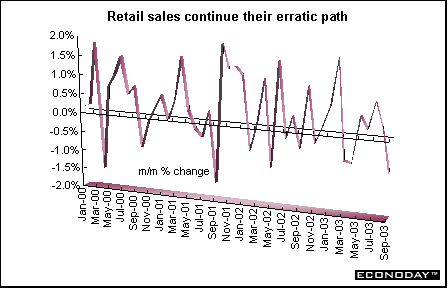
October industrial product price index (IPPI) sank 0.9 percent and was down 3.8 percent when compared with last year. Prices for motor vehicles and other transport equipment continued to fall mainly because of the effect of the exchange rate. Prices were down also for petroleum and coal products, pulp and paper products, electrical and communication products, and chemical products.
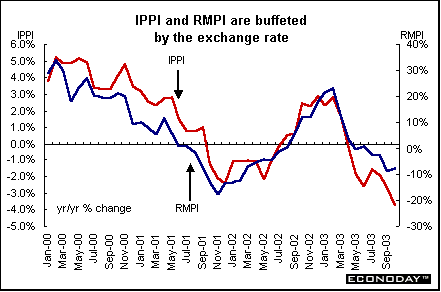
October raw materials price index (RMPI) was up 1.1 but sank 7.8 percent when compared with last year. Mineral fuels contributed to the monthly increase with prices jumping 2.2 percent. Higher prices for non-ferrous metals and wood products also contributed. Lower prices for vegetable products, animals and animal products and ferrous materials dampened the impact. On the year, prices for mineral fuels were responsible for more than half of the drop. Prices for vegetable products, animals and animal products, and wood products were also down on an annual basis. These decreases were partly offset by higher prices for non-ferrous metals and non-metallic minerals.
In October, the value of the U.S. dollar weakened against the Canadian dollar, pushing down prices of commodities that are quoted in U.S. dollars, notably motor vehicles and lumber products. As a result, the total IPPI excluding the effect of the exchange rate would have remained unchanged instead of decreasing 0.9 percent. However, on a 12-month basis, the influence of the dollar is much stronger. Consequently, the IPPI excluding the effect of the exchange rate would have increased 0.9 percent rather than declining 3.8 percent on the year.
September gross domestic product at basic prices rebounded 1.1 percent after plunging 0.7 percent in the previous month because of the massive power outage in Ontario. GDP at basic prices was up 1.9 percent when compared with last year. The largest single contributor to growth was the manufacturing sector, which jumped 2.5 percent. Manufacturing accounted for about 40 percent of the increase in total GDP.
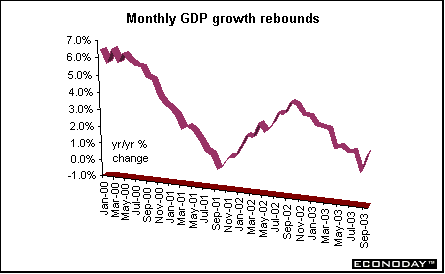
Third quarter gross domestic product inched up 0.3 percent and was up 1.0 percent when compared with the third quarter of last year. Consumer spending and business fixed capital investment were the main sources of strength while exports and business non-farm inventories were the main sources of weakness.
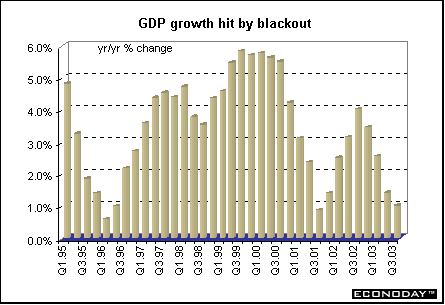
Bottom line
Four central banks will decide policy this week. Investors won't have to wait long to find out what the Bank of Canada decides. On Tuesday, the Bank is expected to announce that it is cutting interest rates by 25 basis points to 2.5 percent. A soaring currency combined with several exogenous events - the August blackout in Ontario and the vestiges of SARS and mad-cow scares in the spring - have weakened the economy. The opposite is expected from the Reserve Bank of Australia on Wednesday. They are expected to announce a 25 basis point increase to their key interest rate for the second month, pushing it up to 5.25 percent. This is the Bank's last meeting until February 2004 and it will probably be reluctant to wait two months before increasing rates again.
The Bank of England and the European Central Bank are expected to keep their rates at 3.75 and 2 percent, respectively. Although Bank of England MPC members acknowledge that November's 25-basis point increase won't be enough to curb record high consumer borrowing or resurgent house price inflation, they have indicated that they are in no rush to increase rates again. Growth remains tepid at best in the EMU even though surveys indicate an uptick in sentiment. Growth thus far has stemmed primarily from exports, which are already under pressure from the rising euro.
Looking Ahead: December 1 through December 5, 2003
